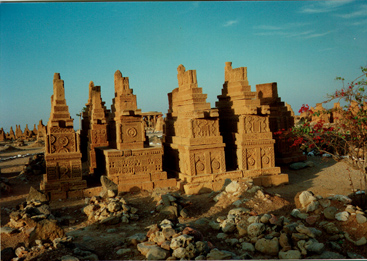Banbhore

Banbhore is an archaeological site situated on the Northern Bank of Gharo Creak, at a distance of about 64 km east of Karachi Pakistan
Banbhore is more than 2,100 years old. . Banbhore covers a considerable area and overlooks a creek that winds its way to sea .Banbhore was once a busy port. This port was center of trade. It can be guess from that near the water the battered remains of sandstone steps still survive. Around the 10th century Banbhore was the capital of a chief Bamboo Raja and was named Bhambor after him. The city was later destroyed in 1250AD. Some scholars identify Banbhore with Daibul, the port city where the 17-year-old Arab Conqueror Mohammad Bin Qasim landed in 712 AD. He was son-in-law and also a general in the army of Hajjaj Bin Yousuf. Hajjaj Bin Yousuf was the governor of Iraq
Hajjaj send army under the leadership of Mohammad Bin Qasim who was only 17 at that time. He attacked India Multan
The first mosque of South East Asia was also built during this period. After the young general conquered the city, Muslims built more mosques, other residential buildings and fifteen walls around the town. Although only ruins are remain of this remarkable city, but the styles of buildings, road networking and drainage system shows the high level standard and vision of people of the area possessed.
The remains of the site include a mosque with numerous Kulfic inscriptions carved on stone slabs. This was first mosque of South East Asia , the bricks which have been used are very modern and remain cool in summer and become hot in winter. A Hindu temple of the pre-Muslim period had also been unearthed along with coins belonging to the Khilafat period. Other stone, glass and ivory objects, pottery, jewellery , arms and some human skeletons with arrows in heads show that this town to violent end.
The pieces of pottery found by archaeologists are similar to those found in Taxila and known to be of the 1st century B.C. Until the 8th century A.D, the city was controlled by Buddhists and than the Hindus. Than Arab came and ruled.
Banbhore is beautiful site with a small museum. This museum traces the history of the port. It has a good display of pottery of various types. Just after entering the museum you can find a model map of Banbhore enclosed in a glass case. The museum also displays pottery, china ware, beads, coins and many other articles used by the people of this ancient land. When we walk around the museum we learn that Banbhore was a well-planned and advanced city. The people had nice tools and equipments to cope up with the daily challenges. For cooling the water, they had a mud-clay-cooler with a long stem at the bottom of the same material. The stem was used to fix in the sand, which kept the water cold. You can also find toys, needles, buttons, etc. A catapult (manjaniq) used for battle is place outside area of the museum.
Banbhore was excavated in 1962. History told that Banbhore was first inhabited by central Asian Sythians and Parthyans, later Alexander the great conquered this place and established a town in 325 BC. This city became the last conquest of Alexander the great f from where he went back westwards and died on his way to Iran South East Asia came in 712 AD.
Banbhore is also associated with the famous romance of Sassi and Punnu. Sassi belonged to Banbhore, but their graves are in “Othal” in Balochistan.
There is also a small lake and a shady picnic area and a rest house. There are many guides appointed by the Pakistan government who provides information to the tourists about Banbhore, which is now a strong archaeological heritage of Pakistan Pakistan


.jpg)



%2BZiarat1.jpg)



